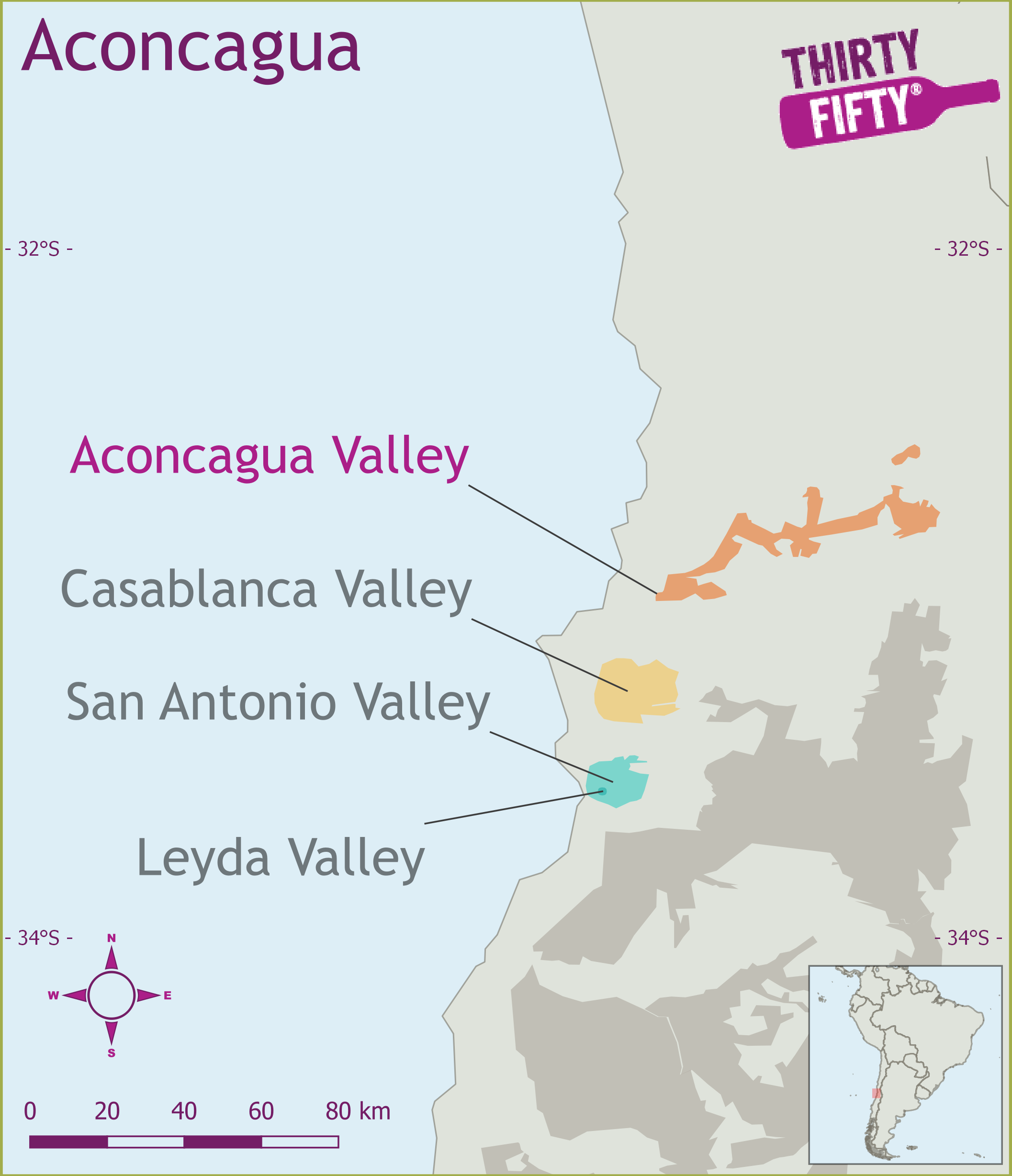Aconcagua Valley's Climate: Warm Maritime
Warm Maritime
Aconcagua Valley's Grapes: Cabernet Sauvignon, Carmenere, Syrah
Cabernet Sauvignon
Cabernet Sauvignon is perhaps the most famous red grape. Its home is Bordeaux where it is was created as a cross between Cabernet Franc (red grape) and Sauvignon Blanc (white grape). Since then its popularity has spread and it is grown all around the world. It prefers warmer climates to ripen fully and even in Bordeaux some years it does not ripen. That is why Cabernet Franc is also used in Bordeaux blends as it ripens faster. What makes Cabernet so popular is not its bouquet, which can range from blackcurrants to cigar box, but its structure, typically having both tannins and acidity to create a smooth feeling in the mouth. The structure allows the blending with other grapes, perhaps the most famous pairing is Cabernet Sauvignon and Merlot where the Cabernet provides the structure and the Merlot gives the wine the soft, rounded feel in the mouth. Recently Cabernet has been mixed with Sangiovese (Chianti's grape) to create the SuperTuscans.
Carmenere
Carmenere is a low-yielding, late-ripening red grape that produces deep-coloured, full-bodied wines. It�s at home in Chile, where more than 4,000 hectares of it are planted, chiefly in the Central Valley. But its roots are in the Medoc, surprisingly since there is so little of it in France now. It was cultivated there in the early 18th century and, with Cabernet Franc, made the reputations of this region�s best chateaux. It was also important in Graves but was abandoned in Bordeaux because of its susceptibility to coulure (poor fruit setting) and its resulting low yields. However, it was transported from there to South America before phylloxera, although it wasn�t until 1994 that a lot of the vines thought to be Merlot in Chile were identified as Carmenere. It is characterised by dark-fruit, cherry and herbal notes, sometimes even a gamey edge, and has the potential to make fine wine. Apart from Chile, Carmenere also turns up in northern Italy, again up until fairly recently under the mistaken identity of Cabernet Franc, as well as California. But, watch this space, it may even be heading for a revival in Bordeaux, where its synonym is Grande Vidure.
Syrah
Shiraz and Syrah are the same grape. However apart from Australia where it is always called Shiraz, and France where it is Syrah, the rest of the world tends to follow the style of these two. If the wine is ripe and full bodied the wine is often called Shiraz. If the wine has less fruit, more acidity and lower alcohol, it tends to be called Syrah after the wines produced into the North of Rhone. Shiraz/Syrah is produced by itself or can be blended typically in three ways. A small amount of the white grape Viognier can lift the deep flavours of Syrah, this is common in Northern Rhone. In Southern Rhone and recently Australia, blending has been based around adding Grenache and Mourvedre, copying the blending behind Chateauneuf-du-Pape. Even more recently Cabernet Sauvignon and Shiraz/Syrah has been blended in the Southern French wine region of Languedoc, creating big wines with elegance. Hotter climate Shiraz often has aromas of plum, tar and leather and with the right oak treatment even chocolate. Cooler climate Syrah can have a peppery note to the wine.
Aconcagua Valley
Pronounced as: ah-kohn-KAH-gwa :
Climate: Warm Maritime
Key Grape Varieties: Cabernet Sauvignon, Carmenere, Syrah

Aconcagua is one of the five principal wine regions of Chile. It encompasses all wine-growing areas in the Valparaíso Region. The Aconcagua wine region is composed of three minor wine districts; Casablanca Valley, Aconcagua Valley and Leyda Valley. Located 65km north of Chile’s capital Santiago, the Aconcagua Valley takes its name from the river flowing through it. The river itself is named after the Andean Mt. Aconcagua, the highest mountain in the America’s, at it’s eastern edge.
Measuring around 60 miles (100km) in length, the valley runs between the slopes of the Andes in the east and the Pacific Ocean in the west. Many wine-growing areas are closely linked to the river and follow its course as it brings fresh meltwater (and mineral-laden silt) down from the Andean peaks to the valley floor. This topography, common to many of Chile's wine-growing areas, means that vineyard altitude in Aconcagua varies from 3300ft (1000m) in the east to 160ft (50m) in the west. It also creates a distinctive climatic characteristic: as the warm, dry land of the region heats up during the afternoon, the hot air in the east rises rapidly upwards, sucking in cooler air from the Pacific Ocean to the west. This process is reversed as the land cools down in the evening. These daily breezes moderate the otherwise high temperatures found in the Aconcagua Valley and reduce the risk of vine disease. The Antarctic 'Humboldt Current' which flows up the west coast of Chile helps to maintain this effect. This Mediterranean climate has 215mm of rain per year.
The Aconcagua Valley lies at a latitude of 32°S (the equivalent latitude in the northern hemisphere crosses through northern Africa and the Middle East), and it is thanks to the climatic and geographical conditions described above that quality wine can be produced in the Aconcagua Valley.
Wine pioneer Don Maximiano Errazuriz planted the first vines here in the hot dry valley and was ridiculed for it. But today the winery started by Errazuriz dominates the area and produces quality Cabernet Sauvignon, Syrah and Merlot.

